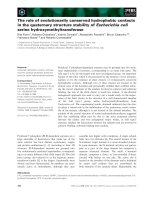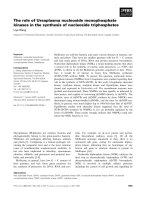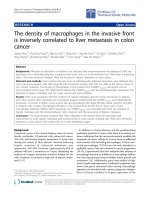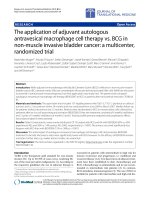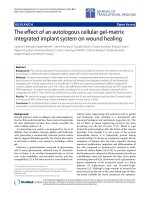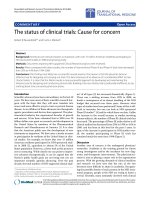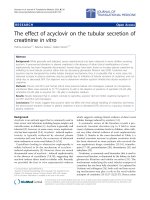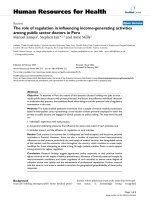báo cáo hóa học: " The role of cumulative physical work load in symptomatic knee osteoarthritis – a case-control study in Germany" potx
Bạn đang xem bản rút gọn của tài liệu. Xem và tải ngay bản đầy đủ của tài liệu tại đây (254.54 KB, 8 trang )
BioMed Central
Page 1 of 8
(page number not for citation purposes)
Journal of Occupational Medicine
and Toxicology
Open Access
Research
The role of cumulative physical work load in symptomatic knee
osteoarthritis – a case-control study in Germany
Andreas Seidler*
1
, Ulrich Bolm-Audorff
2
, Nasreddin Abolmaali
3,4
,
Gine Elsner
5
and the knee osteoarthritis study-group
6
Address:
1
Federal Institute of Occupational Safety and Health, Berlin, Germany,
2
Division of Occupational Health, RP Darmstadt, Wiesbaden,
Germany,
3
Institute of Diagnostic and Interventional Radiology, Johann Wolfgang Goethe-University, Frankfurt am Main, Germany,
4
OncoRay –
MI OncoRay, Dresden, Germany,
5
Institute of Occupational Medicine, Johann Wolfgang Goethe-University, Frankfurt am Main, Germany and
6
The members of the knee osteoarthritis study-group are defined under Acknowledgements
Email: Andreas Seidler* - ; Ulrich Bolm-Audorff - ;
Nasreddin Abolmaali - ; Gine Elsner - ; the knee osteoarthritis study-
group -
* Corresponding author
Abstract
Objectives: To examine the dose-response relationship between cumulative exposure to kneeling
and squatting as well as to lifting and carrying of loads and symptomatic knee osteoarthritis (OA)
in a population-based case-control study.
Methods: In five orthopedic clinics and five practices we recruited 295 male patients aged 25 to
70 with radiographically confirmed knee osteoarthritis associated with chronic complaints. A total
of 327 male control subjects were recruited. Data were gathered in a structured personal
interview. To calculate cumulative exposure, the self-reported duration of kneeling and squatting
as well as the duration of lifting and carrying of loads were summed up over the entire working life.
Results: The results of our study support a dose-response relationship between kneeling/squatting
and symptomatic knee osteoarthritis. For a cumulative exposure to kneeling and squatting > 10.800
hours, the risk of having radiographically confirmed knee osteoarthritis as measured by the odds
ratio (adjusted for age, region, weight, jogging/athletics, and lifting or carrying of loads) is 2.4 (95%
CI 1.1–5.0) compared to unexposed subjects. Lifting and carrying of loads is significantly associated
with knee osteoarthritis independent of kneeling or similar activities.
Conclusion: As the knee osteoarthritis risk is strongly elevated in occupations that involve both
kneeling/squatting and heavy lifting/carrying, preventive efforts should particularly focus on these
"high-risk occupations".
Background
Several epidemiological studies find a relationship
between knee osteoarthritis and physical workplace fac-
tors such as kneeling and squatting as well as lifting and
carrying of loads (for an overview, see Jensen [1]). By now
some European countries (e.g., Denmark, Germany) have
decided to include knee osteoarthritis in the list of occu-
pational diseases. In Denmark, according to the Danish
"List of Occupational Diseases Reported on or after Janu-
ary 1, 2005" [2] the occupational disease No. D.1. is
Published: 14 July 2008
Journal of Occupational Medicine and Toxicology 2008, 3:14 doi:10.1186/1745-6673-3-14
Received: 7 March 2008
Accepted: 14 July 2008
This article is available from: />© 2008 Seidler et al; licensee BioMed Central Ltd.
This is an Open Access article distributed under the terms of the Creative Commons Attribution License ( />),
which permits unrestricted use, distribution, and reproduction in any medium, provided the original work is properly cited.
Journal of Occupational Medicine and Toxicology 2008, 3:14 />Page 2 of 8
(page number not for citation purposes)
defined as follows: "Degenerative arthritis of the knee
joint (arthrosis genus)". In Denmark, kneeling and/or
squatting work for many years is required for recognition
as an occupational disease. In Germany, the German Min-
istry of Health and Social Affairs published the scientific
justification for the recommended inclusion of knee oste-
oarthritis in the German list of occupational diseases in
2005 [3]; this scientific justification had been worked out
by the Medical Expert Board of the Health Ministry. The
scheduled occupational disease is defined as follows:
"Osteoarthritis of the knee by occupational kneeling or
comparable occupational load with a cumulative expo-
sure of at least 13,000 hrs. and a minimum exposure time
of one hour per shift". However, essentially as to date only
few studies have shown a clear dose-response-relationship
between physical workload and the diagnosis of knee
osteoarthritis, recognition criteria are controversially dis-
cussed. The current discussion in several countries con-
cerning the formal recognition that occupational factors
play a role in the development of knee osteoarthritis
would benefit from a more precisely described dose-
response relationship. We therefore conducted a popula-
tion-based case-control study to examine the dose-
response relationship between cumulative exposure to
kneeling and squatting as well as to lifting and carrying of
loads and symptomatic knee osteoarthritis.
Subjects and methods
Study population
Our study was performed in the city of Frankfurt am Main
and surrounding places. In the mentioned region, five
orthopedic clinics surgically treat patients with severe
knee osteoarthritis. Patients were recruited in these five
orthopedic clinics and in five orthopedic practices in
Frankfurt am Main and the neighboring city and adminis-
trative district of Offenbach. Practices from which cases
were drawn were not specialized in workers' compensa-
tion cases or certain industries. Participating physicians
were asked to identify all male patients between 25 and 70
years with knee osteoarthritis associated with chronic
complaints. Recruiting physicians had to state the date of
initial radiographic diagnosis of knee osteoarthritis;
patients were not eligible for the study if the initial diag-
nosis of knee osteoarthritis had been made more than five
years earlier. The median latency period between the date
of diagnosis reported by the physician and the data collec-
tion was 10 months. Of 486 eligible patients, 295 agreed
to participate (61%). Knee X-rays were re-assessed by one
reference radiologist (N.A.) according to the criteria
defined by Kellgren [4]:
Grade 1: doubtful narrowing of joint space and possible
osteophytic lipping;
grade 2: definite osteophytes and possible narrowing of
joint space;
grade 3: moderate multiple osteophytes, definite narrow-
ing of joint space and some sclerosis and possible deform-
ity of bone ends;
grade 4: large osteophytes, marked narrowing of joint
space, severe sclerosis and definite deformity of bone
ends.
To finally qualify as cases, patients had to have at least
grade 2 osteoarthritis according to the reference radiolo-
gist's assessment. 21.7% of the cases had a grade 2 knee
osteoarthritis (n = 64; mean age 56.9 years); 39.7% of the
cases had a grade 3 osteoarthritis (n = 117; mean age 58.2
years); and 38.6% of the cases had a grade 4 osteoarthritis
(n = 114; mean age 61.4 years). 47.5% (n = 140) had a
right-sided knee osteoarthritis, 42.7% (n = 126) had a left-
sided osteoarthritis, and 9.8% (n = 29) had a two-sided
osteoarthritis.
Control subjects were randomly selected from a one per-
cent random sample of male Frankfurt residents aged 25
to 70 years drawn by the Frankfurt and Offenbach popu-
lation registration office. Of 595 population controls, 328
agreed to participate (55%). Non-participation was higher
among younger control subjects and among control sub-
jects with non-German nationality. One control subject
was treated with knee osteoarthritis in a participating
clinic three months after inclusion in the study as a con-
trol subject. This subject was excluded from the control
group (but included in the case group), leaving 327 con-
trol subjects.
A detailed computer-assisted personal interview was
developed to elicit information about worktime physical
workload including kneeling, squatting, lifting and carry-
ing, working postures; psychosocial workload; leisure
activities; life events; and complaints. Questions were sup-
plemented by illustrations where appropriate, for exam-
ple, to explain modes of carrying and specific working
postures (see Fig. 1 for the explanation of kneeling and
squatting, differentiating between two different modes of
squatting). To avoid "questions that cannot be answered"
[5] as far as possible, we did not base our questions
regarding lifting or carrying on abstract categories of
weight, frequency, and duration. Instead, we asked partic-
ipants to describe specific objects that had been lifted or
carried frequently, followed by questions considering
weight, frequency, and duration of lifting or carrying as
directly related to these objects. All subjects also answered
the Nordic questionnaire on musculoskeletal symptoms
[6]. The interviewers documented a complete (self-
reported) occupational history for each participant.
Journal of Occupational Medicine and Toxicology 2008, 3:14 />Page 3 of 8
(page number not for citation purposes)
Interviewers were intensively trained in standardized
interview techniques and a non-differential approach to
cases and controls. Participants were not informed of the
specific aims of the study. They were asked to participate
in a study concerning the theme 'occupation and health'.
Exposure assessment
Job titles were coded blind to the case-control status by
experienced coders in the Frankfurt Institute for Occupa-
tional Medicine, according to the Classification of the
Federal Statistical Office Germany (STBA) [7]. Major occu-
pations were a priori formed on the basis of the two-digit
STBA job-title codes. Cumulative exposure to kneeling/
squatting respectively to lifting/carrying was calculated up
to the year of diagnosis (in cases) or to the year of inter-
view (in control subjects). To calculate cumulative expo-
sure to lifting/carrying, all weights >5 kg lifted or carried
at work were multiplied by the corresponding durations
(assuming 2.5 seconds duration per single lifting act) and
summed. Generally, in cases only exposures up to the date
of first diagnosis were considered for analysis. Subjects
were asked about their age, education, smoking behav-
iour, height, and weight at different ages. A detailed his-
tory of sports activities allowed the calculation of
cumulative hours spent in the following sports: 1. jogging,
athletics; 2. cycling; 3. swimming; 4. soccer; 5. ball games
(handball, volleyball, basketball); 6. apparatus gymnas-
tics, shot put, javelin, hammer throwing, wrestling; and 7.
body building, strength training. The mean age at initial
radiographic diagnosis of knee osteoarthritis was 59.1
years (standard difference 8.5); the mean age of popula-
tion controls on the interview date was 47.9 years (stand-
ard difference 12.5). The mean body mass index of cases
was 26.6 (standard difference 3.8), the mean body mass
index of control subjects was 24.1 (standard deviation
2.9).
Potential confounders and statistics
Odds ratios (OR) and 95% confidence intervals (CI) were
calculated using logistic regression analysis. All statistical
analyses were adjusted for age and place of residence,
referred to as "region" in this text. As age is known to be
strongly associated with the occurrence of knee osteoar-
thritis, and as cases were on average older than control
subjects, we decided to adjust for age. Age was entered
into the logistic regression model in ten-year categories.
Region was considered to be a potential confounder
because occupational exposures were suspected to differ
between regions. Risk by job duration was calculated for
major occupations using two categories of duration (1 to
10 years, more than 10 years). Those who had held a serv-
ice occupation as main occupation were included in the
reference category. Missing values were analyzed as a sep-
arate category (results not shown here). As a-priori
defined procedure, any other variables were categorized in
tertiles based on the distribution of the exposed control
subjects. If less than 20% of the control subjects were non-
exposed, the reference category combined non-exposed
subjects and subjects in the first exposure tertile. If the
highest tertile of exposed control subjects comprised more
than 10% of all (exposed plus non-exposed) control sub-
jects, a high-dose category was generated according to the
95
th
percentile of control subjects. To analyze the com-
bined effect of kneeling/squatting and lifting/carrying, a
new variable was generated on the basis of the respective
highest exposure category: If, for example, a subject had
been assigned to the first exposure category regarding
kneeling/squatting and to the fourth (= highest) category
regarding lifting/carrying (or vice versa), he was assigned
to the fourth exposure category of this "combined" varia-
ble; subjects in the highest exposure category of kneeling/
squatting and to the highest exposure category of lifting/
carrying were assigned to a new (fifth) exposure category
of the combined variable.
Besides the odds ratios solely adjusted for age and region,
odds ratios for the "final model" are given. To particularly
deal with our main hypothesis, the final model should
comprise all factors that could be able to confound the
relationship between kneeling/squatting and knee oste-
oarthritis. Therefore, selection of confounders was done
in two steps: 1. The following factors were considered as
potential confounders as they were correlated with the
cumulative exposure to kneeling and squatting (Kendall-
Tau>0.1): weight (body mass index), cumulative lifting/
carrying, jogging/athletics, weight lifting. 2. Potential con-
founders were included in the final logistic regression
model if they changed the odds ratio of kneeling and
squatting by more than 10% in at least one category. In
the final model, the following confounders were
included: age, region, body mass index, kneeling/squat-
ting, cumulative lifting/carrying, and jogging/athletics (at
a time excluding the considered variable).
Kneeling and squatting, differentiating between two different modes of squattingFigure 1
Kneeling and squatting, differentiating between two
different modes of squatting. *In German: „Fersensitz".
Kneeling
Squatting I Squatting II*
Journal of Occupational Medicine and Toxicology 2008, 3:14 />Page 4 of 8
(page number not for citation purposes)
Power of the study
Calculation of the power of the study was based on an
expected prevalence of kneeling of 9% among the male
population according to Seidler et al. [8]. To detect an
odds ratio of 2.0 with a power of 80% for exposure to
kneeling, we planned to include about 330 cases and con-
trol subjects. With the actually attained 295 cases and 327
control subjects, an odds ratio of 2.0 for kneeling or sim-
ilar activities could be detected with a power of 77%.
These calculations do not take into consideration the loss
of power through differences in confounding factors.
However, as previous studies suggested relatively strong
effects of physical workload on the occurrence of sympto-
matic knee osteoarthritis, our sample size appears rather
adequate.
Results
Occupational groups and physical workload
Table 1 gives the odds ratios for the relationship between
major occupational groups and knee osteoarthritis. Due
to multiple testing, the results of the occupational group
analysis should be regarded as exploratory rather than
hypothesis testing. The power of the study is too small to
obtain interpretable results for rare occupations as floor
layers. In the occupational group analysis, the highest OR
is found among chemical processers and manufacturers of
plastics products. These workers were little exposed to
kneeling/squatting. However, of 20 knee osteoarthritis
cases having worked as chemical processers and manufac-
turers of plastics products, 10 had a cumulative exposure
to carrying/lifting (e.g., through bagging granulate, filling
of mixing vessels or bags, barreling sand) of at least 5,120
kg*hours. Having worked more than 10 years as metal
worker is associated with knee osteoarthritis (OR = 3.0;
95% CI 1.5–6.2). Plasterers, insulators, glaziers, terrazzo
workers, construction carpenters, roofers, and upholsters
show an elevated knee osteoarthritis risk in the long-dura-
tion category (OR = 4.5; 95% CI 1.1–19.4). For wood-
workers, the knee osteoarthritis risk is elevated to 5.7
(95% CI 1.2–28.0) in the high-duration category. Having
worked more than 10 years as painter or varnisher is asso-
ciated with knee osteoarthritis (OR = 6.4; 95% CI 1.5–
27.1). Finally, we find a significantly elevated OR of 4.3
(95% CI 1.6–11.7) among subjects having worked as
physically exposed service workers (storemen, nurses,
refuse collectors) for more than 10 years. When subjects
with non-service work as main occupation ("blue-collar
workers") are compared with "white-collar workers", the
odds ratio for knee osteoarthritis is significantly elevated
to 2.3 (95% CI 1.5–3.5).
For cumulative exposure to kneeling or similar postures
(Table 2) the knee osteoarthritis risk is elevated to 2.4
(95% CI 1.1–5.0) in the highest category (>10,800 hrs.)
adjusted for lifting/carrying. Assuming a linear dose-
response relationship, we find a "doubling dose" of
12,900 hours with kneeling or squatting. The cumulative
exposure to carrying/lifting yields a positive dose-
response relation with disease (independent from kneel-
ing), with an odds ratio of 2.6 (95% CI 1.1–6.1) in the
highest category (>37,000 kg*hours). We find a strongly
increased knee osteoarthritis risk for high exposure to
kneeling/squatting combined with high exposure to lift-
ing/carrying of weights (OR = 7.9; 95% CI 2.0–31.5).
Discussion
In this study, symptomatic knee osteoarthritis was found
to be independently related to kneeling and squatting as
well as to lifting or carrying of weights. Strengths of our
study include the calculation of cumulative exposures
during the entire worktime and adjustment for multiple
potential confounders. Age – which is strongly associated
with knee osteoarthritis risk – was included in 10-years-
categories, making residual confounding possible. When
age – and additionally squared age – was included as a
continuous variable in the regression model, this did not
substantially alter the results. We therefore regard sub-
stantial residual confounding by age as improbable.
Definition of cases and control subjects
Cases were recruited in five orthopedic clinics (n = 238
patients) and five practices (n = 57 patients). When the
case group was restricted to patients treated in orthopedic
clinics, the elevated knee osteoarthritis risk remained
nearly unchanged in the highest exposure category
(results of this subanalysis are available from the
authors); in this subanalysis, the OR for high exposure to
lifting/carrying further increased. As all orthopedic clinics
that surgically treat knee osteoarthritis were included in
the study, we regard bias through choose of participating
medical facilities as an improbable explanation of our
results. Nevertheless a potential association between per-
ceived working conditions and health seeking behavior
given a subjective threshold of pain could somewhat limit
representativeness of the cases included in this study for
all cases with symptomatic knee osteoarthritis, however,
this potential detection bias is difficult to deal with in epi-
demiologic studies.
The low participation rate (61% among cases, 55%
among referents) might have introduced selection bias. To
further evaluate this potential bias, we asked non-partici-
pants by telephone about their longest held job. However,
only 20% (n = 38) of non-participating cases and 24% (n
= 63) of non-participating referents gave their longest held
occupation. According to this scarce information, the pro-
portion of blue-collar workers was slightly higher among
non-participating cases (with known longest held occupa-
tion) compared with participating cases. However, the
proportion of blue-collar workers was considerably
Journal of Occupational Medicine and Toxicology 2008, 3:14 />Page 5 of 8
(page number not for citation purposes)
higher among non-participating referents (with known
longest held occupation) than among participating refer-
ents. Altogether, the non-responder analysis indicates a
potential overestimation of knee osteoarthritis risks
through selection bias; however, because of its strongly
limited representativeness this non-responder-analysis
has to be interpreted with caution.
Due to lack of radiographic examination, the frequency of
knee osteoarthritis is unknown among the population
controls. A suspected prevalence of knee osteoarthritis of
up to 10% among population controls over 55 years [9]
would result in a slight tendency to underestimate poten-
tial risk factors.
Table 1: Occupational groups (reference group: service occupation as main occupation) and symptomatic knee osteoarthritis
Specific occupational groups
a
1 to 10 yrs. in specific occ. group >10 yrs. in specific occ. group
Cases % Controls % Adj. OR
b
95% CI Cases % Controls % Adj. OR
b
95% CI
Agriculture and mining
Agricultural, animal husbandry, and
forestry workers
8 2.7 14 4.3 1.1 0.4–3.4 5 1.7 3 0.9 2.0 0.4–13.0
Production
Chemical processers and
manufacturers of plastics product
6 2.0 7 2.1 0.9 0.2–4.4 14 4.7 3 0.9 16.1 3.1–84.8
Manufacturers of paper and paper
products; printers
2 0.7 2 0.6 - - 10 3.4 5 1.5 2.5 0.7–9.1
Metal processers, blacksmiths 10 3.4 2 0.6 6.2 1.2–31.4 8 2.7 2 0.6 5.1 0.7–35.4
Metal workers (machinery fitters,
machine assemblers, mechanics,
manufacturers of precision
instruments; plumbers, welders,
sheet metal and structural metal
preparers and erectors)
29 9.8 41 12.5 1.0 0.5–2.0 39 13.2 25 7.6 3.0 1.5–6.2
Electrical and electronics workers 5 1.7 17 5.2 0.2 0.1–0.8 10 3.4 14 4.3 1.2 0.4–3.1
Tanners, fellmongers, pelt dressers;
shoemakers and leather goods
makers
5 1.7 1 0.3 5.2 0.5–49.0 2 0.7 3 0.9 0.8 0.1–5.4
Food and beverage processors;
tobacco product makers
10 3.4 8 2.4 1.5 0.5–4.9 8 2.7 10 3.1 0.9 0.2–3.4
Construction workers
(structural engineering, civil
engineering)
14 4.7 9 2.8 2.6 0.9–7.5 9 3.1 4 1.2 2.1 0.5–8.7
Plasterers, insulators, glaziers,
terazzo workers, construction
carpenters, roofers; upholsterers
5 1.7 8 2.4 0.5 0.1–2.1 9 3.1 5 1.5 4.5 1.1–19.4
Woodworkers and plastic workers
(carpenters, cabinet makers,
wooden or plastic models makers,
wood-frame construction)
8 2.7 7 2.1 1.8 0.5–6.5 7 2.4 3 0.9 5.7 1.2–28.0
Painters; varnishers 4 1.4 7 2.1 0.7 0.2–2.9 9 3.1 4 1.2 6.4 1.5–27.1
Quality inspectors; packers 8 2.7 3 0.9 7.3 1.3–41.4 3 1.0 2 0.6 1.3 0.1–12.8
Labourers 5 1.7 11 3.4 0.8 0.2–3.1 - - - - - -
Operators
(crane and earth-moving machinery
operators etc.)
3 1.0 2 0.6 1.5 0.2–13.7 2 0.7 1 0.3 - -
Technology
Technicians (engineers, architects,
chemists, physicists, electrical
engineering technicians)
15 5.1 21 6.4 1.0 0.4–2.3 42 14.2 31 9.5 1.8 0.9–3.3
Services
Service workers: Storemen, nurses,
refuse collectors
15 5.1 20 6.1 1.2 0.5–2.9 17 5.8 8 2.4 4.3 1.6–11.7
Soldiers 3 1.0 4 1.2 1.5 0.2–11.2 1 0.3 1 0.3 - -
Other service workers 1 0.3 6 1.8 0.2 0.02–1.9 - - 1 0.3 - -
a
Occupations with <10 subjects are not shown
b
Adjusted for age, region, body-mass index, and jogging/athletics
Journal of Occupational Medicine and Toxicology 2008, 3:14 />Page 6 of 8
(page number not for citation purposes)
Self-reported physical workload
Calculation of cumulative physical workload was based
on self-reported data regarding duration of kneeling or
similar activities, the weight of lifted or carried objects,
and the frequency of lifting. Several studies have led to the
conclusion that self reported exposure data cannot validly
replace observations or direct measurements in the assess-
ment of physical workload [10-12]. Undoubtedly, if
cumulative exposures are hypothesized to play an etio-
logic role in knee osteoarthritis, prospective studies with
direct measurements would be preferable, but would take
long time. In addition, workplaces are changing with a
tendency towards decreasing physical workload over
time, which diminishes potential risks and would there-
fore limit conclusions concerning the probability of occu-
pational causation of current knee osteoarthritis.
Therefore, despite their methodological limitations, in
our opinion, self-reported data remain an important and
practicable tool in the assessment of physical workload.
One major potential limitation of self-reported data con-
cerns the possibility of differential recall bias: Patients
with knee osteoarthritis may overestimate their physical
workload (more strongly than control subjects). In a com-
parison of self-reported physical work load against task
analysis and observation (n = 36 men in the forest indus-
try) Viikari-Juntura et al. [13] revealed a correlation coef-
ficient between the questionnaire and observation ratings
of 0.49 for frequency of lifting, carrying, and transferring
6–15 kg. Concerning the frequency of lifting, carrying,
and transferring 6–15 kg, the self-assessed and observed
values showed for most factors better correlation for the
workers with no pain than for the workers with severe
pain. In a study conducted by Wiktorin et al. [14] muscu-
loskeletal complaints seemed to cause differential bias in
the self-reported exposures to lifting. In general, a differ-
ential overestimation of physical workload by cases
would lead to an overestimation of risks. Otherwise, a
non-differential overestimation of physical workload (in
both cases and control subjects) would lead to an under-
estimation of risks. We therefore cannot reliably estimate
the true effect of potential recall bias on the risk estimates.
However, recall bias should not play an important role in
the probands' report of job titles. As the occupational
group analysis reveals elevated risks in occupations with a
suspected high exposure to kneeling as well as to lifting/
carrying of loads (e.g., metal workers, terrazzo layers,
painters), in our opinion recall bias is not a sufficient
explanation for the positive association between physical
workload and symptomatic knee osteoarthritis.
The ratio of case to control interviews differed markedly
between interviewers, potentially introducing interviewer
bias. However, additional adjustment for interviewer did
not substantially alter the results.
Table 2: Occupational exposure to kneeling/squatting and lifting/carrying of loads and symptomatic knee osteoarthritis
Variable Cases Controls
N%N%Adj. OR
a
95% CI Adj. OR
b
95% CI
Kneeling and squatting combined
No kneeling/squatting 145 49.2 208 63.6 1.0 - 1.0 -
>0 – <870 h 15 5.1 39 11.9 0.7 0.3–1.5 0.5 0.2–1.2
870 – <4,757 h 32 10.8 40 12.2 1.4 0.8–2.5 0.8 0.4–1.5
4,757 – <10,800 h 40 13.6 22 6.7 2.8 1.5–5.4 1.6 0.8–3.4
> = 10.800 h 62 21.0 17 5.2 4.0 2.1–7.6 2.4 1.1–5.0
Cumulated lifting and carrying combined (kg*hrs.)
No lifting/carrying 75 25.4 153 46.8 1.0 - 1.0 -
>0 – <630 kg*hrs. 28 9.5 58 17.7 1.3 0.7–2.4 1.2 0.6–2.3
630 – <5,120 kg*hrs. 61 20.7 58 17.7 2.0 1.2–3.4 2.0 1.1–3.6
5,120 – <37,000 kg*hrs. 92 31.2 40 12.2 3.6 2.1–6.0 2.0 1.1–3.9
> = 37,000 kg*hrs. 35 11.9 17 5.2 3.5 1.7–7.2 2.6 1.1–6.1
Kneeling/squatting and lifting/carrying combined
c
Both no kneeling/squatting and no lifting/carrying 65 22.0 137 41.9 1.0 - 1.0 -
Kneeling/squatting >0 – <870 hrs. or lifting/carrying >0 – <630 kg*hrs. 26 8.8 58 17.7 1.2 0.7–2.3 1.1 0.5–2.1
Kneeling/squatting 870 – <4,757 hrs. or lifting/carrying >0 – <5,120
kg*hrs.
42 14.2 59 18.0 1.3 0.8–2.4 1.2 0.7–2.2
Kneeling/squatting 4,757 – <10,800 hrs. or lifting/carrying 5,120 – <37,000
kg*hrs.
78 26.4 42 12.8 3.5 2.0–6.0 2.7 1.5–4.8
Either kneeling/squatting >10,800 hrs. or lifting/carrying >37,000 kg*hrs.
d
69 23.4 26 8.0 3.8 2.1–6.8 3.4 1.8–6.3
Both kneeling/squatting >10,800 hrs. and lifting/carrying >37,000 kg*hrs. 14 4.7 4 1.2 7.8 2.1–28.3 7.9 2.0–31.5
a
Adjusted for age and region
b
Adjusted for age, region, body mass index, jogging/athletics, kneeling/squatting, and lifting/carrying (without considered variable)
c
The respective highest exposure (concerning kneeling/squatting and lifting/carrying) is crucial for exposure classification
d
If both conditions are fulfilled, the subject is assigned to the highest exposure category
Journal of Occupational Medicine and Toxicology 2008, 3:14 />Page 7 of 8
(page number not for citation purposes)
Plausibility of results
The observed association between kneeling or similar
activities as well as lifting or carrying weights with the
diagnosis of symptomatic knee osteoarthritis is in accord-
ance with the literature [1,15-17]. While the existence of
this relationship has been confirmed by several studies,
few studies consider the dose-response relationship. In
their case-control study, Sandmark et al. [18] compare
patients who had undergone a total knee replacement
with randomly selected population controls. The authors
find a positive dose-response relationship between self-
reported cumulative exposure to kneeling and total knee
replacement: Among men with a cumulative exposure to
kneeling of more than 2,700 (maximum 23,900) hours,
the mentioned study finds an OR of 2.1 (95% CI 1.4–3.3)
adjusted for age, body mass index, and smoking. When
additional confounders are included in the regression
model (e.g., lifts at work), the OR slightly decreases. In a
cross-sectional study among floor layers, carpenters, and
compositors (as a control group without knee demands),
Jensen [19] examines the association between knee-strain-
ing work and knee osteoarthritis. Videotaping was done to
measure exposure to kneeling. Jensen [19] finds a positive
dose-response relationship between knee osteoarthritis
and both the total number of squatting and the duration
of kneeling work. D'Souza et al. [20] examine the relation-
ship between the daily amount of kneeling and knee oste-
oarthritis in the subset of participants at the Third
National Health and Nutrition Examination Survey who
received knee X-rays (n = 2,589). The authors find a posi-
tive dose-response relationship between the daily amount
of kneeling and knee osteoarthritis with an OR of 2.37
(95% 1.27–4.45) for subjects kneeling more than 14% of
the workday. Otherwise, Coggon et al. [17] find no dose-
response relationship for the cumulative duration (in
years) of kneeling more than one hour per day. In accord-
ance with three [18-20] of four studies examining the
dose-response relationship between knee-straining work
and knee osteoarthritis, our study yields a positive dose-
response relationship between kneeling/squatting as well
as lifting/carrying and knee osteoarthritis. Our risk estima-
tors for cumulative hours of kneeling or similar activities
are comparable with the risk estimators reported by Sand-
mark et al. [18]: Adjusting for age and region, we find a
significantly elevated knee osteoarthritis risk for cumula-
tive exposure to kneeling/squatting of more than 4,757
hours; in the final model (additionally adjusting for lift-
ing/carrying, body mass index, and jogging/athletics) we
find a significantly elevated knee osteoarthritis risk for
cumulative exposure to kneeling/squatting of more than
10,800 (maximum 62,975) hours. It is difficult to esti-
mate the separate effects of kneeling and squatting, as
these activities are relatively highly correlated.
Even though four previous studies have examined the
association between knee osteoarthritis and kneeling
combined with heavy lifting [8,17,21,22], this study is the
first to investigate the dose-response relationship for the
combination of kneeling and heavy lifting. According to
our study the knee osteoarthritis risk is particularly ele-
vated in occupations that involve both kneeling/squatting
and heavy lifting/carrying (OR = 7.9; 95% CI 2.0–31.5).
In our study, combined exposures occur, for example,
among tilers, warehouse clerks, assemblers, carpenters,
building fitters, and bricklayers. Ergonomic and organiza-
tional interventions should particularly focus on these
"high-risk occupations".
Some experimental studies suggest that knee bending
leads to elevated tibiofemoral joint forces. Thambyah et
al. [23] applied forces in the knee derived from previous
studies of human walking and squatting to five cadaver
knees that underwent mechanical testing. In deep knee
flexion, peak stresses were over 80% larger than peak
stresses in walking; peak stresses in deep knee flexion
reached the damage limits of cartilage. According to the
results of this biomechanical study the adequacy of artic-
ular cartilage to support loads in the knee joint during
deep flexion might be questioned.
Conclusion
In conclusion, our results support a dose-response rela-
tionship between kneeling/squatting and symptomatic
knee osteoarthritis with a "doubling duration" of about
13,000 hours. In our study, lifting/carrying of weights is
independently associated with the diagnosis of sympto-
matic knee osteoarthritis. As the knee osteoarthritis risk is
strongly elevated in occupations that involve both kneel-
ing/squatting and heavy lifting/carrying, preventive
efforts should particularly focus on these "high-risk occu-
pations".
Competing interests
The authors declare that they have no competing interests.
Authors' contributions
AS conceived the study design, performed the statistical
analysis and drafted the manuscript, UB participated in
the study design and and helped to draft the manuscript,
NA participated in the design of the study and performed
the re-assessment of all X-rays, GE coordinated the study
and helped to draft the manuscript. The members of the
knee osteoarthritis study group (see under acknowledg-
ment) participated in the acquisition of data and were
involved in revising the manuscript. All authors read and
approved the final manuscript.
Acknowledgements
This work was supported by a grant from the Hans-Böckler-Foundation
and the industrial union IG BAU. We would like to thank the members of
Publish with BioMed Central and every
scientist can read your work free of charge
"BioMed Central will be the most significant development for
disseminating the results of biomedical research in our lifetime."
Sir Paul Nurse, Cancer Research UK
Your research papers will be:
available free of charge to the entire biomedical community
peer reviewed and published immediately upon acceptance
cited in PubMed and archived on PubMed Central
yours — you keep the copyright
Submit your manuscript here:
/>BioMedcentral
Journal of Occupational Medicine and Toxicology 2008, 3:14 />Page 8 of 8
(page number not for citation purposes)
the knee osteoarthritis study-group for their valuable contributions to this
study. The following members contained within the study-group: Akan Gül,
Sebastian Ridder, Dimitrios Bechtsis, Leif Reefschläger, Elke Ball, Ilias Vre-
zas (Institute of Occupational Medicine, Johann Wolfgang Goethe-Univer-
sity, Frankfurt am Main, Germany), Winfried Beck (Orthopedist,
Offenbach, Germany), Adalbert Missalla (Ortho-Clinic Rhein-Main, Offen-
bach, Germany), Christian Hanusa (Orthopedic University Clinic, Erlangen,
Germany), Reinhard Hoffmann (Center for Trauma Surgery and Ortho-
pedic Surgery, Frankfurt am Main, Germany and Clinic Offenbach, Offen-
bach, Germany), Louis Hovy, Wolfgang Schaub (General Hospital
Frankfurt-Hoechst, Frankfurt am Main, Germany), Alwin Jäger (Center for
Trauma Surgery and Orthopedic Surgery, Frankfurt am Main, Germany),
Andreas Misko, Annette Oboth, Richard Rehm, Andrzej Sztulman (Ortho-
pedists, Frankfurt am Main, Germany), Thomas Vogl (Institute of Diagnostic
and Interventional Radiology, Johann Wolfgang Goethe-University, Frank-
furt am Main, Germany), Hannes Wacha (Hospital zum heiligen Geist,
Frankfurt am Main, Germany), and Ludwig Zichner (Orthopedic Surgeon,
Frankfurt/Main, Germany).
References
1. Jensen LK: Knee osteoarthritis : Influence of work with heavy
lifting, kneeling, climbing stairs or ladders, or combining
kneeling/squatting with heavy lifting. Occ Environ Med 2008,
65:72-89.
2. National Board of Industrial Injuries (Arbejdsskadestyrelsen):
Administrative Order No. 333 of March 15, on the List of
Occupational Diseases Reported on or after January 1, 2005.
[ />tegn%20BE333%2015032007.pdf].
3. Bundesministerium für Gesundheit und Soziale Sicherung: Wissen-
schaftliche Begründung für die Berufskrankheit „Gonar-
throse durch eine Tätigkeit im Knien oder vergleichbarer
Kniebelastung mit einer kumulativen Einwirkungsdauer
während des Arbeitslebens von mindestens 13.000 Stunden
und einer Mindesteinwirkungsdauer von insgesamt einer
Stunde pro Schicht". Bundesarbeitsblatt 2005:46-54.
4. Kellgren JH: Atlas of standard radiographs of arthritis. Vol II.
The epidemiology of chronic rheumatism. Oxford Blackwell Sci-
entific 1963.
5. Burdorf A, Beek AJ van der: In musculoskeletal epidemiology
are we asking the unanswerable in questionnaires on physi-
cal load? [editorial]. Scand J Work Environ Health 1999, 25:81-83.
6. Kuorinka I, Jonsson B, Kilbom A, Vinterberg H, Biering-Sorensen F,
Andersson G, Jörgensen K: Standardised Nordic questionnaires
for the analysis of musculoskeletal symptoms. Appl Ergonom
1987, 18:233-237.
7. Klassifizierung der Berufe–Systematisches und alpha-
betisches Verzeichnis der Berufsbenennungen–Ausgabe
1992. Edited by: Statistisches Bundesamt. Stuttgart: Metzler-Poeschl;
1992.
8. Seidler A, Hornung J, Heiskel H, Börner M, Elsner G: Gonarthrose
als Berufskrankheit? Zbl Arbeitsmed 2001, 51:106-117.
9. Peat G, McCarney R, Croft P: Knee pain and osteoarthritis in
older adults: a review of community burden and current use
of primary care. Ann Rheum Dis 2001, 60:91-97.
10. Wiktorin C, Selin K, Ekenvall L, Kilbom A, Alfredsson L: Evaluation
of perceived and self-reported manual forces exerted in
occupational manual materials handling. Appl Ergonom 1996,
27:231-239.
11. Beek A Van der, Frings-Dresen MHW: Assessment of mechanical
exposure in ergonomic epidemiology. Occup Environ Med 1998,
55:291-299.
12. Kumar S: Perception of posture of short duration in the spa-
tial and temporal domains. Appl Ergonom 1993, 24:345-350.
13. Viikari-Juntura E, Rauas S, Martikainen R, Kuosma E, Riihimäki H,
Takala EP, Saarenmaa K: Validity of self-reported physical work
load in epidemiologic studies on musculoskeletal disorders.
Scand J Work Environ Health 1996, 22:251-259.
14. Wiktorin C, Karlqvist L, Winkel J, Stockholm MUSIC I study group:
Validity of self-reported exposures to work postures and
manual materials handling.
Scand J Work Environ Health 1993,
19:208-214.
15. Maetzel A, Mäkelä M, Hawker G, Bombardier C: Osteoarthritis of
the hip and knee and mechanical occupational exposure – a
systematic overview of the evidence. J Rheumatol 1997,
24:1599-1607.
16. Cooper C, Coggon D: Physical activity and knee osteoarthritis.
Lancet 1999, 353:2177-2178.
17. Coggon D, Croft P, Kellingray S, Barrett D, McLaren M, Copper C:
Occupational physical activities and osteoarthritis of the
knee. Arthr Rheum 2000, 43:1443-1449.
18. Sandmark H, Hogstedt C, Vingard E: Primary osteoarthritis of
the knee in men and women as a result of lifelong physical
load from work. Scand J Work Environ Health 2000, 26:20-25.
19. Jensen LK: Knee-straining work activities, self-reported knee
disorders and radiographically determined knee osteoarthri-
tis. Scand J Work Environ Health 2005, 31(Suppl 2):68-74.
20. D'Souza JC, Werner RA, Keyserling WM, Gillespie B, Rabourn R, Ulin
S, Franzblau A: Analysis of the third national health and nutri-
tion examination survey (NHANES III) using expert ratings
of job categories. Am J Ind Med 2008, 51:37-46.
21. Felson DT, Hannan MT, Naimark A, Berkeley J, Gordon G, Wilson
PW, Anderson J: Occupational physical demands, knee bend-
ing, and knee osteoarthritis: results from the Framingham
Study. J Rheumatol 1991, 18:1587-1592.
22. Cooper C, McAlindon T, Coggon D, Egger P, Dieppe P: Occupa-
tional activity and osteoarthritis of the knee. Ann Rheum Dis
1994, 53:90-93.
23. Thambyah A, Goh JC, De SD: Contact stresses in the knee joint
in deep flexion. Med Eng Phys 2005, 27:329-335.
